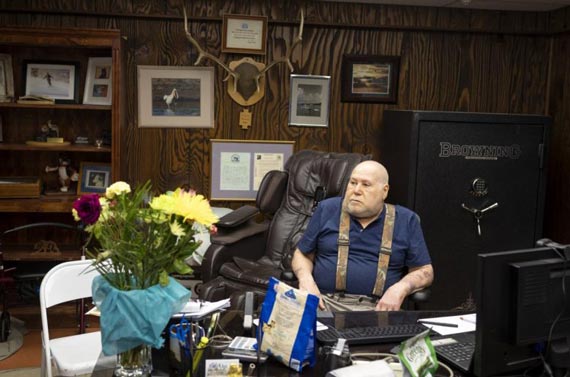 Loading... Please wait...
Loading... Please wait...- Contact
- wiggys@wiggys.com
- Home
- News + Commentary
- An Article About Wiggy's from the Colorado Sun
Recent Commentary
News & Commentary Archives
Learn More
Subscribe to Wiggy's Newsletter » Receive updates about new products, specials, and learn about insulation technology
An Article About Wiggy's from the Colorado Sun
Posted by jerry wigutow on May 2nd, 2023
By Jason Blevins. View the article in The Colorado Sun
This Grand Junction company makes the "world's best sleeping bags" — but you won't find them in stores
As more businesses look for success in Colorado's Grand Valley, Wiggy's remains one of the mainstays of the region's growing outdoor recreation industry
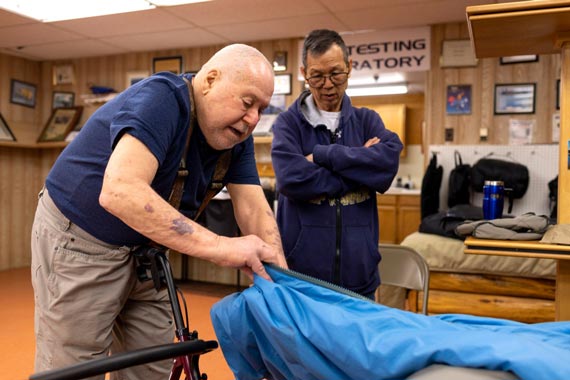
GRAND JUNCTION — Put your hand right here, says Kok Bou, holding out a 12-inch square of insulated fabric that will soon be part of a
Wiggy's sleeping bag.
"It's hot, isn't it?" he asks.
In 1988, Jerry Wigutow, the founder of Wiggy's, held out a piece of his Lamilite Climashield continuous filament fiber and asked Bou to put his hand on it. He wanted to hire Bou, who fled his home country of Cambodia in the 1970s as the Khmer Rouge murdered millions. Bou had spent about a decade working for Marmot Mountain Works in Grand Junction. He was unsure about this brash textile expert touting a unique technology: laminated continuous filament fiberfill as insulation for sleeping bags. Then he did that hand test and saw a future with Wigutow.
"You don't get that from any other product. That's what kept me here all these years," Bou says amid the hum of the Wiggy's factory.
Now Bou and Wigutow are partners in Wiggy's, headquartered in a nondescript building on the edge of Grand Junction where 25 to 35 workers have spent decades cutting, sewing and selling — direct to consumer — what they call "the world's best sleeping bags" insulated with continuous filament fiber.
"Never, ever in my wildest dreams," says Bou of his 35-year career at Wiggy's.
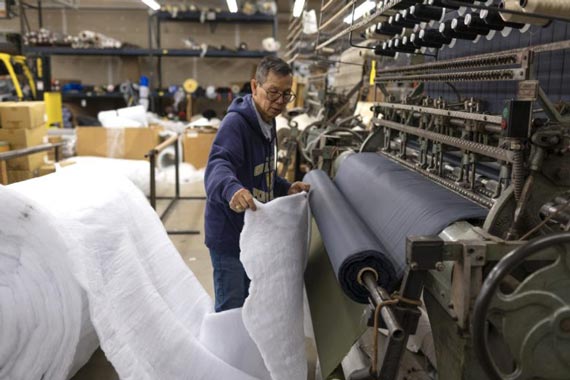
Wigutow started working with continuous filament fiberfill in the late 1960s, selling the insulation that back then was largely being used in pillows. As Wigutow recognized the potential of the packable, durable, water-resistant insulation, he started courting big-name outerwear makers to include the fiberfill in ski parkas and outerwear.
"Nobody wanted to buy it," the 81-year-old says from his wood-paneled office next to the factory floor where machines he hand-built have been cranking out insulation for sleeping bags nonstop since 1988.
You see, he says, continuous filament polyester does not need quilting or stitching to hold it in place. It can be used in large sheets without the need for baffling that is required to keep down or chopped insulation that resembles cotton balls in place in jackets and bags.
"I told them if you laminate the continuous fiber, you have uniform thickness and don't need that quilting stitching, but because it didn't look like a down bag with all the stitching, they said no," Wigutow says. "So I got tired of trying to sell to them … and decided to make my own."
Sleeping bags you can actually sleep in
Today, Wiggy's is the only U.S. manufacturer of sleeping bags.
"That is not true," he says, gruffly correcting a visitor perched in front of his massive desk. "I'm the only manufacturer of sleeping bags in the world. The reason I say that is because Wiggy's is the only sleeping bag that actually works. All those other sleeping bag companies that claim to make sleeping bags make no-sleep sleeping bags."
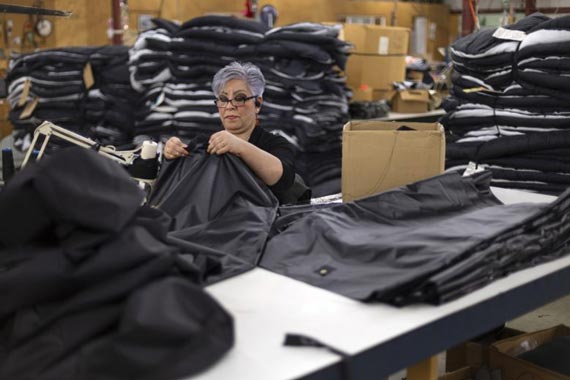
Wigutow makes his bags for the military, search and rescue teams, hunters and Arctic explorers. He still sells largely through mail order, ranking as a pioneer in the now red-hot direct-to-consumer retail trend. He eschews advertising in outdoor magazines, preferring to do all his trumpeting on his
website, which includes five chapters of his life story, a long treatise on the value of continuous filament fiber and pages of testimonials from Wiggy's fans. If a retailer wants to carry Wiggy's, he tells them "if you want my bag you have to eliminate all these other brands.
"They don't want to do that," he says.
He offers a lifetime warranty on everything he makes. He uses YKK #10 zippers, the burliest made by the global zipper-maker. He encourages customers to wash the bags over and over. His prices are competitive with major brands. (For example: a minus-60-degree bag goes for $295, 0-degree bags are $220 and a 20-degree bag is $165. Discounts and sales can shave those prices.)
Hanging in the small display area of his factory is a green bag that was used for 40 years by a North Carolina Boy Scout leader. It was one of the first bags Wigutow made before spinning out on his own and creating Wiggy's.
"It looks brand new," he says.
Major brands can get large numbers of returns from customers unhappy with their sleeping bags, he says.
"I don't have any returns," he says. "I have returning customers."
Andrew Leary is one of those customers. In 2013, he was set to guide his first expedition to the North Pole. He was expecting temperatures to reach 40 below zero. He hadn't heard of Wiggy's before but other guides heralded the bags.
"It's pretty incredible what they can do," said Leary, who used Wiggy's Antarctic bag , rated to minus 60, on that 2013 expedition and every North Pole trip since. "It's like putting on a comfortable pair of sweatpants after wearing a suit all day. I sleep perfectly every night."
Today, all the clients on North Pole expeditions with Polar Explorers, where Leary works as a guide, get Wiggy's bags. Yeah, they are bulkier and a tad heavier than expedition-weight down bags. But in the Arctic, where there's high humidity with frigid temperatures and the constant threat of breaking through the ice into water, your sleeping bag simply can't fail. Lightweight, while popular, is risky in extreme conditions, Leary said.
"We need durability and reliability and that's Wiggy's," says Leary, who doesn't do any cheerleading for other outdoor brands but hails Wiggy's. "The product has not changed. It's incredible and Jerry has stayed true to his vision."

Why change a good thing? At all.
Wigutow has not altered his approach since launching Wiggy's in Grand Junction in the late 1980s with about 35 workers. He was making bags for the Forest Service back then. Now, he's down to about 25 workers, making orders for individuals, special operations forces and Arctic survival kits for the Air Force, which include insulated gear pressed with a machine Wigutow built into airtight bricks that fit beneath the ejection seats of jets.
The same machines — and a lot of the same workers — make bags the exact same way today. He started making insulating jackets and vests several years ago but stopped in 2019 as he struggled to hire enough workers.
"We decided we needed to focus on what we do best," he says, pushing his walker alongside Cookie, his standard poodle, around the factory floor and visiting with his team of sewers, cutters and order-fillers.
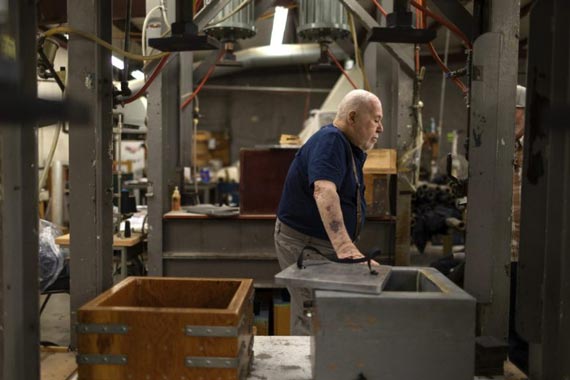
Like Stella Renteria, who was on the factory floor the day Wiggy's opened 35 years ago. Today she does "a little bit of everything," handling shipping, receiving, quality control and other jobs around the shop.
"We have the best employees. They put all their heart into everything we make and it's obvious in our products," she says, mirroring the unbridled pride of her boss in the Wiggy's bags. "Our quality is 100%. I'd never buy anything different."
Wiggy's remains one of the stalwarts in Grand Junction's growing outdoor recreation industry.
When businesses start scoping Grand Junction as a possible home as part of the region's work to expand beyond a decadelong reliance on extractive industries, the Grand Valley's eco-devo boosters point to Wiggy's as an example of how businesses can sustain and thrive.
"We have seen multiple outdoor recreation companies come here over the last several years, and these companies are always wanting to know how it has gone for other companies who have made the move to the Grand Junction area," says Curtis Englehart, the executive director of the Grand Junction Economic Partnership. "We can confidently point them to Jerry and Wiggy's as an ideal example of how a company invested in our area a number of years ago and is still thriving."
Back when Wigutow arrived, the Grand Valley economy was limping. Exxon had pulled the plug on its $5 billion oil shale extraction project, laying off 2,200 Western Slope workers in a move that decimated the region. They call the day Exxon made that announcement in May 1982 "Black Sunday."
There were a handful of companies that arrived in Grand Junction in the late 1980s thanks to local economic-development grants and incentives.
"I'm the only one left," Wigutow says.
So what happens when Wigutow, who isn't married and doesn't have kids, wants to retire? People have been asking him that for years, he says.
He tells them about the 18 months he spent on his boat sailing to the Bahamas 50 years ago, saying "I retired once." He tells them about visiting his parents so many years ago in a Florida retirement community and seeing "all these old men vegetating."
"They were dying because they had nothing to do. This is what I do," he says, back at his desk, next to a signed poster of Chuck Yeager, who was a Wiggy's fan. "I am retired."
